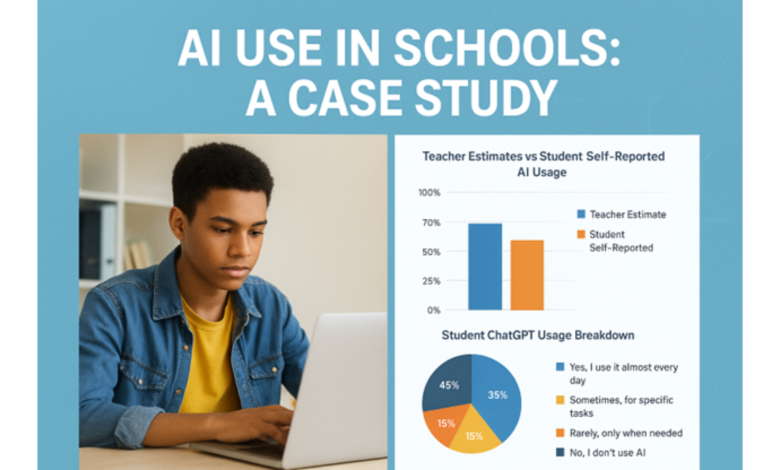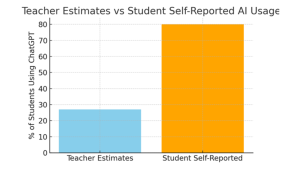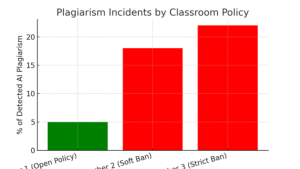
Introduction
Artificial intelligence (AI) tools like ChatGPT are increasingly integrated into students’ academic lives. While discussions often focus on potential misuse or ethical concerns, AI is also shaping how students learn, brainstorm, and approach assignments. This article presents a small observational case study exploring AI usage in high school classrooms, teacher perceptions, student habits, and implications for future education.
Student Usage Patterns
To better understand AI adoption, three teachers were interviewed, and 100 students were surveyed. Students reported significantly higher AI usage than teachers expected. While teachers estimated that, on average, 27% of students used AI for schoolwork, 80% of students indicated they used ChatGPT at least sometimes, with 45% using it almost daily.
Figure 1: Teacher Estimates vs Student Self-Reported AI Usage
Students reported using AI for brainstorming essays, organizing study plans, generating ideas for projects, and checking concepts. One student noted, “I use ChatGPT every day for brainstorming and making an outline. It saves me a ton of time.” Another shared, “If ChatGPT went away, I’d still finish my work but it would take much longer.”
Teacher Policies and Classroom Approaches
The teachers interviewed had different approaches to AI in their classrooms:
- Teacher 1 (Open Policy): AI is allowed as a research tool, akin to using Google. Students are instructed on citation, responsible use, and prompt crafting. Plagiarism incidents were low, at 5%.
- Quote: “We treat AI like a search engine — students must cite and show process. Teaching how to use it reduces misuse.”
- Teacher 2 (Soft Ban): No formal policy, AI is discouraged. Plagiarism incidents were 18%.
- Quote: “I see students handing in work that looks formulaic — hard to tell if it’s them or AI. We’ve banned it for now.”
- Teacher 3 (Strict Ban): Explicit prohibition with academic integrity enforcement. Plagiarism incidents were 22%.
- Quote: “Students still use it secretly — many underestimate how widespread it is.”
Figure 2: Plagiarism Incidents by Classroom Policy
Comparing Policies and Outcomes
Interestingly, the classroom that openly allowed AI use experienced the lowest plagiarism rates. This suggests that teaching responsible AI use may be more effective than banning AI entirely. By educating students on citations, fact-checking, and critical evaluation, misuse can be mitigated while still harnessing AI as a learning tool.
Figure 3: Student ChatGPT Usage Breakdown
Implications for Education
AI literacy is increasingly critical for students’ academic success. The perception gap between teachers and students indicates that educators may underestimate the extent of AI adoption. Incorporating AI responsibly into the curriculum can enhance learning efficiency, encourage independent thinking, and develop digital literacy skills.
Teacher Insights
All teachers agreed that AI is becoming a fixture in student work. Open discussion and instruction on AI use help students navigate the fine line between assistance and overreliance. Responsible usage fosters creativity and problem-solving, while bans often fail to prevent secretive or improper use.
Student Insights
Students overwhelmingly view AI as a tool that aids their learning rather than replaces effort. One student noted, “Teachers think we don’t use AI, but everyone in my grade has used it at least once.” Another highlighted that structured guidance reduced misuse: “When the teacher showed us how to cite AI output and check facts, fewer kids tried to submit AI-only work.”
Conclusion
This case study demonstrates that AI is widely used among students and that teachers often underestimate its adoption. Open policies paired with guidance on responsible use can reduce plagiarism and help students leverage AI as a learning aid. As AI tools continue to evolve, integrating them thoughtfully into education will be crucial for preparing students to navigate a technology-driven world.







